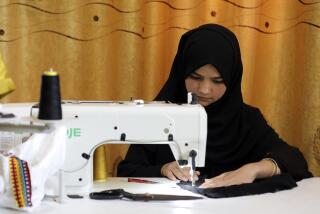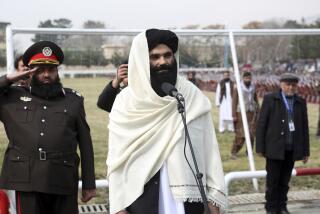Afghans Learning to Be All They Can Be
- Share via
KABUL, Afghanistan — Lying on their backs at a military academy compound here, about 30 bearded men in green camouflage fatigues do bicycle pedals in the air before turning on their stomachs for a rough approximation of push-ups.
Welcome to the new Afghan National Army, troop strength 1,800 and, ever so slowly, growing.
From these humble beginnings, the country’s transitional government under President Hamid Karzai hopes to create a nonfactional, multiethnic force of 60,000 to 80,000 that would be able to take on enemies of a much larger size.
The idea promulgated by Karzai and supported by Western countries is that a nonfactional army equipped by various donor countries would break Afghanistan out of its pattern of civil war and conflict among private armies fighting for land, people and resources.
A viable national army would mean extending security to all corners of the country, not just the area around this capital city now protected by international peacekeepers. And having that security would, many believe, build support for the government and undermine those people chafing for the return of the Taliban, who at least kept the streets safe.
The biggest question mark is the country’s warlords, who have militias of their own. How are they going to respond to the upstart national corps?
And, almost as worrying, will the men here in training, all bound by ethnic and tribal loyalties, be able to transcend them to serve a democratically elected civil government?
Lt. Col. Kevin M. McDonnell, commander of the U.S. Army’s 1st Battalion, 3rd Special Forces Group, which since April has been carrying out training with the French army, was hearing no such doubts.
“This is the Afghan National Army,” he said flatly. And training “is going great.”
McDonnell acknowledged that warlords could be threatened by the emergence of a national army, but that is no reason not to keep going, he said. “The longer this continues, the more credibility we’ll have.
“A lot of people have come into Afghanistan and made promises, a lot of them. The Afghan people are waiting to see if the concept of the Afghan National Army really works. They are waiting to see if the international community has the patience and persistence to make this work.”
And he believes that the army can be a crucible to break down some of the divisions in the country. “As time goes by,” he said, “the ethnic and tribal ties will start to fade.”
At the training academy, the U.S. Special Forces, their bigger bulk and their desert camouflage distinguishing them from the thin Afghan soldiers in green, strode about barking instructions and giving encouragement as translators struggled to keep up. The trainees were using Kalashnikov rifles donated by Romania, Albania and Bulgaria.
The decision to not give them U.S. M-16s was because the Russian-designed automatic rifle is much more familiar in Afghanistan, having been the preferred weapon during the country’s past decades of war, first against Soviet occupation and then for power among various factions.
One basic lesson has been how to aim a gun. Contrary to the image of the skilled fighter, many of the trainees had never used the sights on their weapons, said Maj. Steve Stover, a Pentagon public affairs officer.
The Afghan way had been to keep the gun on full automatic and simply spray the enemy.
Another lesson being taught is to suppress the Afghan idea that a soldier is loyal first of all to his commander.
“We tell them that they do not have to support any one person but the elected government of Afghanistan,” Stover said.
On a recent September morning, two battalions in training--one in its sixth week under the aegis of the U.S. Special Forces, and one just starting under their French trainers--were assembled side by side outside their barracks. They were a study in contrasts--the one group in their smart battle-dress uniforms and caps lining up quickly and quietly, the other in a motley assortment of tunics, robes, hats and turbans, lounging insolently or stretched out on the ground waiting for something to happen.
Within a short time, the soldiers show potential, according to their U.S. trainers.
At a practice session to teach them how to fire mortars, after having had only two days’ instruction, the recruits split into crews and safely assembled scores of Iranian-made 82-millimeter mortar rounds and began firing on targets as far as 2 1/2 miles away. (The risk of an accidental explosion made watching this exercise fairly terrifying.)
Through trial and error, they’d lay a round on their target after three or four tries, and--once they had hit their mark--follow it with a blitz of concussions echoing off the mountains beyond.
“They’re doing super,” said a lanky Special Forces officer who gave his name only as Timothy, who said the rounds were falling within about 35 yards of their target. “Using what they’ve got, they’re doing pretty good.”
While training, the recruits get a monthly salary of $30, to be increased to $50 upon successful completion.
So far, of the 500 to 600 recruits in each of the five battalions being trained, about 150 to 200 have dropped out.
Mainly, soldiers said, they were discouraged by the tough physical regimen and the modest pay, which they considered insufficient compensation for being far from home and unable to contribute to their families’ upkeep.
McDonnell said he wasn’t concerned. This level of “erosion” is normal in any army, he said, and part of the purpose of basic training is to weed out the weak soldiers.
A Proud Graduate
Most people would consider Abdul Rahman, 33, a fairly experienced fighter. Five years ago, he volunteered for the Northern Alliance and fought with it against the Taliban.
He had his own Kalashnikov, was repeatedly tested under fire and attained the rank of captain by the time the victorious northern forces poured into Kabul last November.
Today the stocky young man in a short reddish beard is swaggering--but not because of his past. He is proud because he has graduated in the first battalion to be trained by international forces back in April.
“Before, we just fought randomly and used our own tactics,” he said one recent evening. “But now we have learned real military tactics to defeat our enemies. Now I really feel like a real soldier.”
His enthusiasm aside, however, most experts on the country believe that there is a long way to go to build a new army.
Already there have been sharp disagreements among rival commanders, and between Afghan military officers and their foreign allies, over who should have military power and how it should be wielded.
The problems have contributed to reported friction between Defense Minister Mohammed Qassim Fahim and Karzai over how quickly the old Northern Alliance military command should be replaced by a more ethnically balanced officer corps, and how quickly the vast number of moujahedeen veterans should be disarmed and re-integrated into civilian life.
As Northern Alliance commander since the assassination of Ahmed Shah Masoud last year, Fahim had his own militia. When the Taliban fell, his militia entered Kabul and started to style itself as the national army. But because the Northern Alliance was composed almost exclusively of ethnic Tajiks--and its leading officers more specifically Tajiks from one area, Masoud’s Panjshir Valley--it has not gained the full trust of Pushtuns or members of other ethnic groups.
There remain indications that Fahim and the Panjshir officer corps are lukewarm toward the troops being trained by the United States and France. Fahim was notably absent at the first graduation ceremony of a foreign-trained battalion in April. The soldiers have reported having trouble getting weapons, pay or assignments from the ministry.
In August, the Defense Ministry issued a draft policy statement on forming the national army that barely mentions the training program and seems to imply that its graduates would be put into a national guard, not the army.
Most of the draft policy is concerned with getting moujahedeen veterans from the Northern Alliance and other militias to register their weapons, after which the most suitable fighters would be assigned to units and trained for army service, and the rest would be re-integrated into civilian life, including job training and financial assistance.
But the international community remains strongly committed to the training program to build an army from scratch. President Bush has pledged to help Afghanistan develop its army and police force, in part to remove the need for ongoing international peacekeepers in the country.
The reason is clear. So far, the international community has been able to pony up only 5,000 troops to provide security in Kabul. Under the overall command of Turkey, international patrols sweep through the capital daily, working with local police, checking sites that might be targets for terrorist bombings, and setting up temporary roadblocks to screen cars for explosives or weapons. As a result, the capital has a modicum of security.
State of Near Anarchy
But that isn’t the case for much of the rest of Afghanistan. In Mazar-i-Sharif in the north, there have been frequent clashes between rival warlords, leading to shootings in the street. The lack of security is one reason U.N. officials say that school attendance is lagging behind in some districts around Mazar. And unlike Kabul, few women in Mazar have dared to shed their burkas while untrustworthy gunmen still roam unhindered.
Similarly, in the east of the country, the absence of international peacekeepers has allowed a state of near anarchy around Khowst and Gardez, where a disgruntled ousted governor has continued to harass the local officials recognized in Kabul. And in some rural areas to the south, vestiges of the Taliban have been able to emerge and intimidate the local population.
All of which argues for the country to get the kinks ironed out and to get the new national force moving as quickly as possible, Afghan and foreign officials here believe.
As Karzai declared in a television address as early as January, “The rule of the gun is the greatest obstacle to everlasting peace and security in our country.”
More to Read
Sign up for Essential California
The most important California stories and recommendations in your inbox every morning.
You may occasionally receive promotional content from the Los Angeles Times.













